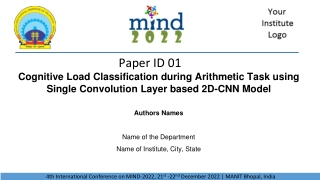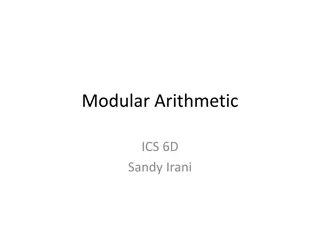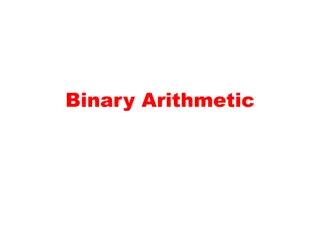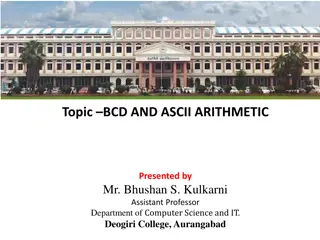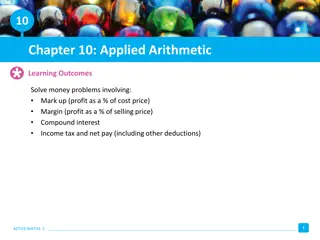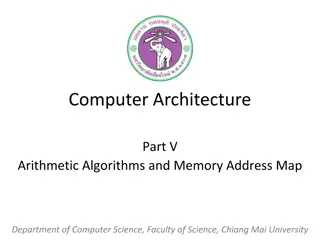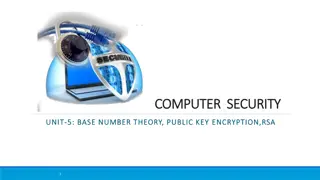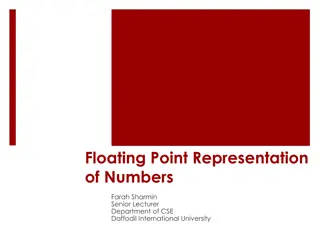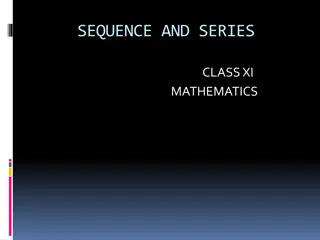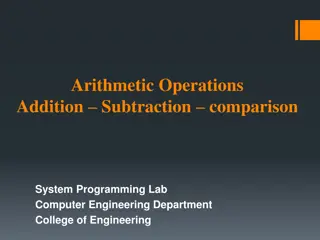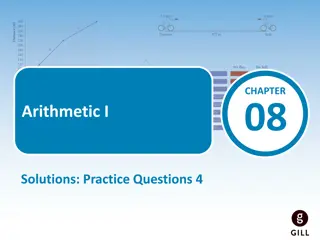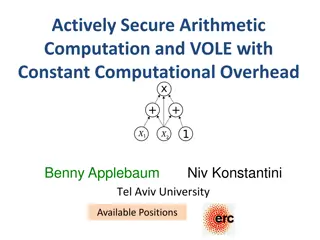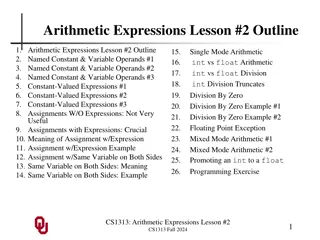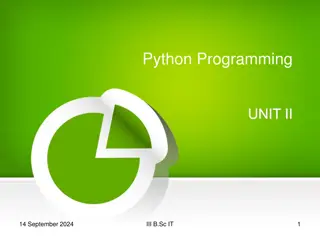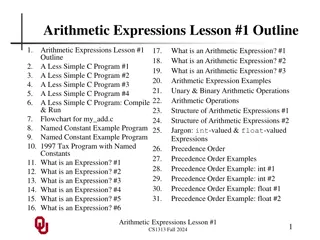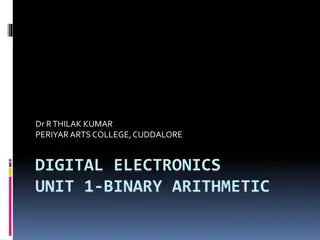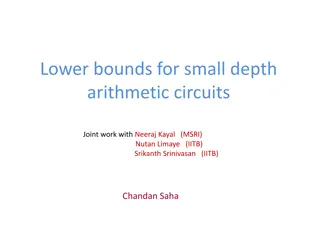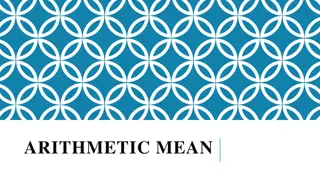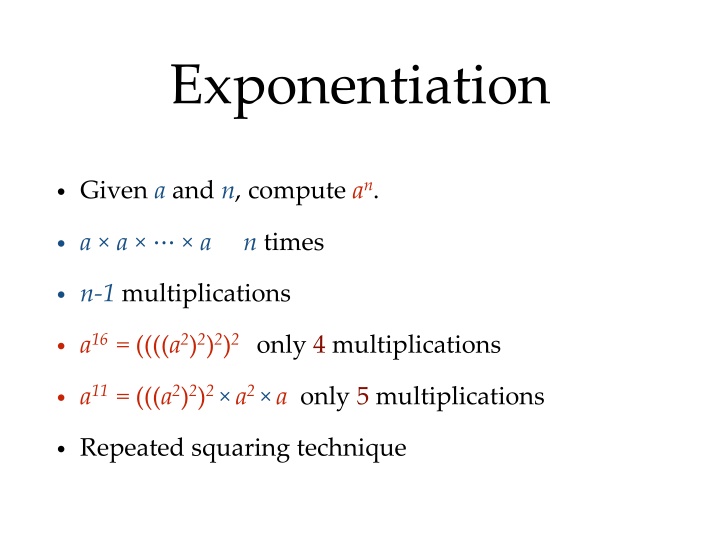
Advanced Exponentiation Techniques for Efficient Computations
Learn about efficient exponentiation methods like repeated squaring and their applications in reducing the number of multiplications required for computing powers of a number, Fibonacci numbers, and more. Understand how these techniques can optimize arithmetic operations and improve computational efficiency.
Download Presentation

Please find below an Image/Link to download the presentation.
The content on the website is provided AS IS for your information and personal use only. It may not be sold, licensed, or shared on other websites without obtaining consent from the author. If you encounter any issues during the download, it is possible that the publisher has removed the file from their server.
You are allowed to download the files provided on this website for personal or commercial use, subject to the condition that they are used lawfully. All files are the property of their respective owners.
The content on the website is provided AS IS for your information and personal use only. It may not be sold, licensed, or shared on other websites without obtaining consent from the author.
E N D
Presentation Transcript
Exponentiation Given a and n, compute an. a a a n times n-1 multiplications a16 = ((((a2)2)2)2 only 4 multiplications a11 = (((a2)2)2 a2 a only 5 multiplications Repeated squaring technique
Repeated Squaring Number of multiplications Exp(a, n) : If n is even T(n) T(n/2) + 2 return ( Exp(a, n/2) )2 T(n) 2 log n If n is odd return ( Exp(a, (n-1)/2) )2 a If n is 1 return a
Another implementation Exp(a, n) : If n is even return ( Exp(a2, n/2) ) If n is odd return ( Exp(a2, (n-1)/2) ) a If n is 1 return a
Iterative implementation Input: a, n Initialize a_power_n 1; // this will be anat the end a_two_power a; // this will be a2^iafter i iterations while (n > 0) If (n is odd) then a_power_n a_two_power a_power_n; a_two_power a_two_power a_two_power; n n/2 //integer part after division by 2 //or right-shift by 1 bit
Repeated squaring Does it give the minimum number of multiplications? What about a15 ? can be done in 5 multiplications Given n, what the minimum number of multiplications required for an ? No easy answer. Can apply repeated squaring for other operations like Matrix powering. Apparently proposed by Pingala (200 BC ?).
Fibonacci numbers F(n) = F(n-1) + F(n-2) Used by Pingala to count the number of patterns of short and long vowels. Here again we are repeating the same operation n times. Can repeated squaring be used? Can we compute F(n) in O(log n) arithmetic operations?
Fibonacci numbers F(n) = F(n-1) + F(n-2) if n is even F(n) = F(n/2) F(n/2-1) + F(n/2+1)F(n/2) = F(n/2) (2F(n/2+1) - F(n/2)) F(n+1) = F(n/2) F(n/2) + F(n/2+1)F(n/2+1) similarly, if n is odd
Integer Multiplication Addition: Adding two n bit numbers School method O(n) time O(n) time is necessary to write the output. Multiplication: multiplying two n bit numbers School method O(n2) time is O(n2) time is necessary?
Integer Multiplication Kolmogorov (1960) conjectured that O(n2) time is necessary. In a week, Karatsuba found O(n1.59) time algorithm. Karatsuba quoted in Jeff Erickson s Algorithms After the seminar I told Kolmogorov about the new algorithm and about the disproof of the n2 conjecture. Kolmogorov was very agitated because this contradicted his very plausible conjecture. At the next meeting of the seminar, Kolmogorov himself told the participants about my method, and at that point the seminar was terminated.
Special case: Integer Squaring If we have a squaring algorithm, does it directly give us a multiplication algorithm? Input: n bit integer a Break it into two chunks n-1 bits and 1 bit a = + 2 b a2 = 2 + 2 b + b2 T(n) = T(n-1) + O(n) = O(n2)
Squaring: divide and conquer Input: n bit integer a Break it into two chunks: n/2 bits and n/2 bits a = b + c 2n/2 . a2 = b2 + 2 b c 2n/2 + c22n Need to compute the multiplication bc recursively. How to compute bc with the square function? 2bc = (b+c)2 - b2 - c2
Squaring: divide and conquer Input: n bit integer a Break it into two chunks: n/2 bits and n/2 bits a2 = b2 + (b2 + c2 - (b-c)2 ) 2n/2 + c22n Squaring an n bit number reduced to squaring three n/2 bit numbers and few additions and left shifts O(n) T(n) = 3 T(n/2) + O(n)
Running time analysis T(n) = 3 T(n/2) + O(n) T(n) c n + 3 T(n/2) for some constant c T(n) c n + 3cn/2 + 32 T(n/22) T(n) c n + 3cn/2 + 32 cn/22 + 33 T(n/23) T(n) c n + 3cn/2 + 32 cn/22 + + 3k-1 cn/2k-1 + 3k T(n/2k) Assuming n = 2k and T(1) = 1 T(n) c n (1 + 3/2 + 32/22 + + 3k-1/2k-1) + 3k T(n) 2 c n (3k/2k - 1) + 3k (2c+1) 3k = O(3k) = O(3log n ) = O(nlog 3 )
Karatsubas multiplication Input: n bit integers a and b Break integers into two chunks: n/2 bits and n/2 bits a = a0 + a1 2n/2 . b = b0 + b1 2n/2 . ab = a0 b0 + (a0b1 + a1b0) 2n/2 + a1b12n Want to compute the three terms a0 b0, (a0 b1 + a1 b0), a1 b1 with only three multiplications and a few additions T(n) = 3 T(n/2) + O(n) T(n) = O(nlog 3 ) = O(n1.585 )
Toom-Cook multiplication Break it into three chunks: n/3 bits each a = a0 + a1 2n/3 + a2 22n/3 b = b0 + b1 2n/3 + b2 22n/3 ab = a0 b0 + (a0b1 + a1b0) 2n/3 + (a0b2 + a1b1 + a2b0) 22n/3 + (a1b2 + a2b1) 23n/3 + a2b2 24n/3 In how many multiplications of n/3 bit numbers, can you find these five terms?
Toom-Cook multiplication ab = a0 b0 + (a0b1 + a1b0) 2n/3 + (a0b2 + a1b1 + a2b0) 22n/3 + (a1b2 + a2b1) 23n/3 + a2b2 24n/3 In how many multiplications of n/3 bit numbers, can you find these five terms? If six multiplications T(n) = 6 T(n/3) + O(n) T(n) = O(n(log 6)/(log 3) ) = O(n1.63 ) If five multiplications T(n) = 5 T(n/3) + O(n) T(n) = O(n(log 5)/(log 3) ) = O(n1.46 )
Toom-Cook multiplication Homework: find these five terms using five multiplications and a few additions a0 b0 a0b1 + a1b0 a0b2 + a1b1 + a2b0 a1b2 + a2b1 a2b2
Toom-Cook multiplication Homework: find these five terms using five square operations and a few additions P2 PQ 2PR + Q2 QR R2
Integer multiplication history Karatsuba: break integers into two parts: O(n1.585 ) Toom-Cook: break integers into three parts: O(n1.46 ) What if break into more parts? can get better and better time complexity by increasing the number of parts for k parts, we will get O(k2nlog (2k-1) / log k) we can get O(n1+ ) for any constant > 0
Integer multiplication history for k parts, we will get O(k2nlog (2k-1) / log k) we can get O(n1+ ) for any constant > 0 Exercise:how many parts to break into for O(n1.1) Theoretically faster, but not necessarily faster in practice due to large constants. For multiplying 64 bit integers, Karatsuba may not be faster than school method. A combination of the two may be faster.
Integer multiplication history [1960] Karatsuba O(n1.585 ) [1963, 1966] Toom-Cook: O(n1.46 ) [1981] Donald Knuth: O(n 2 (2 log n) log n) [1971] Sch nhage Strassen: O(n log n loglog n) [2007, 2008] F rer, De-Kurur-Saha-Saptharishi: O(n log n 2log* n) [2019] Harvey-van der Hoeven: O(n log n) Conjecture: O(n log n) can not be improved
Matrix multiplication Input: n n matrices A and B Break matrices into four parts: n/2 n/2 each Want to compute the four matriceswith only seven multiplications and a few additions
Polynomial multiplication Input: degree d polynomials P and Q P(x) = p0 + p1 x+ p2 x2 + + pd xd. Q(x) = q0 + q1 x+ q2 x2 + + qd xd. P(x)Q(x) = p0 + (p0q1+p1q0)x+ + pdqd x2d. Assume integer multiplication in unit time. School multiplication O(d2) time. Can we do better?
Next week Quiz: Wednesday, Jan 31, 8:30 AM, open notes Polynomial multiplication, Fast Fourier transform Puzzle: secret sharing Share secret among n parties If any k of them come together, the secret can be reconstructed.
Polynomial multiplication A(x) = a0 + a1 x + a2 x2 + + ad-1 xd-1 B(x) = b0 + b1 x + b2 x2 + + bd-1 xd-1 A(x)B(x) = a0 b0 + (a0b1 + a1b0) x + (a0b2 + a1b1 + a2b0) x2 + + ad-1bd-1 x2d-2 2? 2 ? ?? A(x)B(x) = ?=0 ???? ? ?=0
Polynomial multiplication A(x)B(x) = a0 b0 + (a0b1 + a1b0) x + (a0b2 + a1b1 + a2b0) x2 + + ad-1bd-1 x2d-2 Assuming unit cost arithmetic operations, what is the time complexity? Naive algorithm O(d2) Can we use Karatsuba s idea for polynomial multiplication?
Convolution a = (a0, a1, a2 , ,am-1) Rm b = (b0, b1, b2 , ,bn-1) Rn a b = (a0 b0 , (a0b1 + a1b0) , (a0b2 + a1b1 + a2b0) , , ( ????? ?) , am-1bn-1 ) Rm+n-1 Dot product with a sliding window
Applications of Convolution Signal processing Smoothening of noisy data Covid cases per day: take seven day averages Image processing: 2D convolution (bivariate polynomial multiplication) Convolutional neural networks
Source: https://en.wikipedia.org/wiki/Kernel_(image_processing)
Applications of Convolution Probability distribution of a sum of two random variables Dice with Outcome 1 2 3 4 5 6 Probability 0.2 0.3 0.1 0.1 0.2 0.1 Sum of two such dice Outcome 1 2 3 4 5 6 7 . . . Probability 0 0.04 0.12 .
Polynomial multiplication/ Convolution Can we get faster than the naive O(d2) algorithm? Different representations of a polynomial coefficients roots evaluations Claim: given d evaluations, there is a unique degree d-1 polynomial satisfying those evaluations.
Unique polynomial with d evaluations Claim: given d evaluations, there is a unique degree d-1 polynomial satisfying those evaluations. Proof: Suppose there are two different degree d-1 polynomials P(x) and Q(x) which have the same d evaluations. Define R(x) = P(x) - Q(x). Then R(x) is zero at these d points But, a degree d-1 polynomial cannot have d roots. Contradiction.
Roots of a polynomial Claim: A (nonzero) degree d-1 polynomial can have at most d-1 roots Proof: We prove it by induction. Base case: degree 1 polynomial has exactly one root. Induction hypothesis: a degree d-2 polynomial has at most d-2 roots Induction step: Let P(x) be a polynomial of degree d-1. Let be a root of P(x). Then x- divides P(x). Let P(x) =(x- ) Q(x). If P( ) = 0 for some , then Q( ) = 0. Hence, all other roots of P(x) are also roots of Q(x). By induction hypothesis, Q(x) has at most d-2 roots. Hence, P(x) has at most d-2+1 = d-1 roots.
Polynomial representations Computations with different representations Addition Multiplication O(d2) O(d2) Coefficients ? O(d) Roots O(d) O(d) Evaluations But, can we convert between different representations?
Polynomial Representations Given d coefficients, how much time needed to compute evaluations of the polynomial at d points? Naively, each evaluation will need O(d) multiplications and additions Overall time O(d2) Can evaluation at one point help with evaluating at another point?
Coefficients to evaluations A(x) = a0 + a1 x + a2 x2 + + ad-1 xd-1 A(1) = a0 + a1 + a2 + + ad-1 A(-1) = a0 - a1 + a2 - - ad-1 Total additions = 2d-2 First compute even-sum = a0 + a2 + a4 + + ad-2 odd-sum = a1 + a3 + a5 + + ad-1 A(1) = even-sum + odd-sum A(-1) = even-sum - odd-sum Total additions = d
Coefficients to evaluations Similar trick with A( ) and A(- ) A(x) = a0 + a1 x + a2 x2 + + ad-1 xd-1 Aeven(x) = a0 + a2 x + a4 x2 + + ad-2 xd/2-1 Aodd(x) = a1 + a3 x + a5 x2 + + ad-1 xd/2-1 A( ) = Aeven( 2) + Aodd( 2) A(- ) = Aeven( 2) - Aodd( 2) Two evaluations of degree d-1 polynomial Two evaluations degree d/2-1 polynomials
Coefficients to evaluations A( ) = Aeven( 2) + Aodd( 2) A(- ) = Aeven( 2) - Aodd( 2) Evaluations of A(x) at , - , , - , , - , . Evaluations of Aeven(x) and Aodd(x) at 2, 2, 2, . Total work reduced by half Can we further apply this trick? We will need 2 = - 2 ?
Roots of unity Evaluations of A(x) at 1, -1, i, -i Evaluations of Aeven(x) and Aodd(x) at 1, i2 = -1 Evaluations of Aeven-even(x) , Aeven-odd(x) , Aodd-even(x) , Aodd-odd(x) at 1 To generalize assume d = 2t We will start with d-throots of unity.
Roots of unity a + i b = r e i r = (a2 + b2) is the absolute value = tan-1(b/a) is the angle with real axis e i = -1 Primitive d-th root of unity = = e2 i / d All d-th roots of unity = 1, , 2, 3, ., d-1
Properties of roots of unity Primitive d-th root of unity = = e2 i / d d/2 = e2 i / 2 = -1 All d-th roots of unity = 1, , 2, 3, ., d-1 All (d/2)-th roots of unity = 1, 2, 4, 6, ., 2d-2 1 + + 2+ 3 + + d-1 = 0 1 + j+ 2j+ 3j + + (d-1)j = 0 for 0 < j < d
Discrete Fourier Transform Evaluate a degree d-1 polynomial at d-th roots of unity Evaluations of A(x) at 1, , 2, 3, ., d-1 (d-th roots) Given a0 , a1 , a2 , , ad-1 Output a0 + a11 + a212 + + ad-1 1d-1 a0 + a1 + a2 2 + + ad-1 d-1 a0 + a1 2 + a2 4 + + ad-1 2d-2 a0 + a1 d-1 + a2 2d-2 + + ad-1 2d-1
Fourier Transform ?(?)???(2???)?? ?(?) = ?(?)???(2???)?? ?(?) = ?(?)?2????? ?(?) + ??(?) =
Fast Fourier Transform Evaluations of A(x)at 1, , 2, 3, ., d-1 Assume d is a power of 2 Aeven(x) = a0 + a2 x + a4 x2 + + ad-2 xd/2-1 Aodd(x) = a1 + a3 x + a5 x2 + + ad-1 xd/2-1 -1= d/2 A( ) = Aeven( 2) + Aodd( 2) - = 1+d/2 . A(- ) = Aeven( 2) - Aodd( 2) - d/2-1= d/2+d/2-1 = d-1 Squares of the d-th roots : 1, 2, 4, ., 2(d/2-1) (d/2-th roots)
Fast Fourier Transform Cooley-Tukey 1965 Evaluations of A(x) at 1, , 2, 3, ., d-1 (d-th roots) Recursively evaluate Aeven(x) and Aodd(x) at 1, 2, 4, 6, ., d-2 (d/2-th roots) For 0 k d/2-1 A( k) = Aeven( 2k) + k Aodd( 2k) A( k+d/2) = Aeven( 2k) - k Aodd( 2k)
Fast Fourier Transform Let T(d) be the time to evaluate a degree d-1 polynomial at d-th roots of unity. For 0 k d/2-1 A( k) = Aeven( 2k) + k Aodd( 2k) A( k+d/2) = Aeven( 2k) - k Aodd( 2k) T(d) = 2 T(d/2) + O(d) T(d) = O(d log d)
Polynomial multiplicaiton/convolution Coefficients Evaluations (FFT) O(d log d) Pointwise multiply evaluations of the two polynomials O(d) Evaluations Coefficients (inverse FFT) Inverse FFT is just FFT with replaced by -1 O(d log d)
Inverse FFT Inverse FFT is just FFT with replaced by -1 = d-1 e0 = a0 + a11 + a212 + + ad-1 1d-1 e1 = a0 + a1 + a2 2 + + ad-1 d-1 ed-1 = a0 + a1 d-1 + a2 2d-2 + + ad-1 2d-1 da0 = e0 + e11 + e212 + + ed-1 1d-1 da1 = e0 + e1 -1 + e2 -2 + + ed-1 -d+1 dad-1 = e0 + e1 -d+1 + e2 -2d+2 + + ed-1 -2d+1
FFT Implementation issues Can we really do additions/multiplications with roots of unity in constant time? approximations: how many bits sufficient? Requires careful implementation. modular arithmetic: work modulo a large enough prime, such that d-th roots of unity exist. Is it fast in practice? Iterative implementation, which is memory efficient FFT convolution faster than direct convolution for d=128

